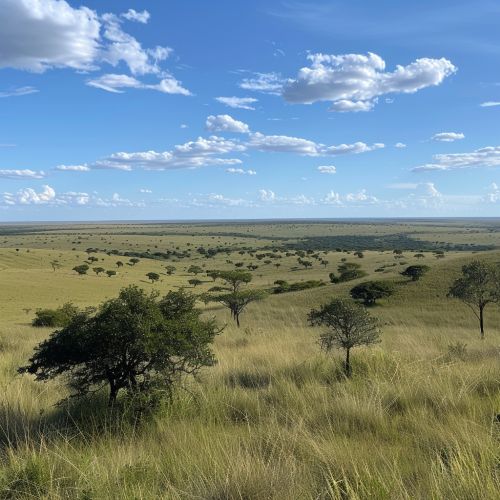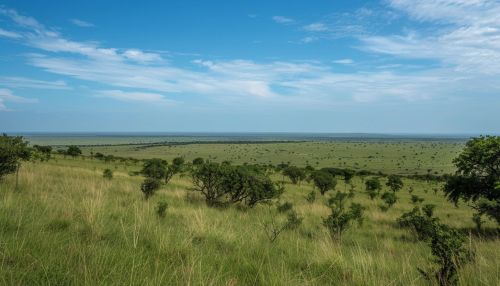Llanos (South America): Difference between revisions
(Created page with "== Geography and Climate == The Llanos are vast tropical grasslands situated to the east of the Andes in Colombia and Venezuela. Covering an area of approximately 600,000 square kilometers, the Llanos are characterized by their flat terrain and distinct wet and dry seasons. The region is bounded by the Orinoco River to the north and the Amazon Rainforest to the south. The climate of the Llanos is classified as tropical savanna, with a...") |
No edit summary |
||
| Line 5: | Line 5: | ||
The climate of the Llanos is classified as tropical savanna, with a pronounced wet season from May to October and a dry season from November to April. During the wet season, the region experiences heavy rainfall, leading to extensive flooding. The dry season, on the other hand, is marked by high temperatures and scarce precipitation. | The climate of the Llanos is classified as tropical savanna, with a pronounced wet season from May to October and a dry season from November to April. During the wet season, the region experiences heavy rainfall, leading to extensive flooding. The dry season, on the other hand, is marked by high temperatures and scarce precipitation. | ||
[[Image:Detail-91473.jpg|thumb|center|Expansive view of the Llanos grasslands with scattered trees under a blue sky.|class=only_on_mobile]] | |||
[[Image:Detail-91474.jpg|thumb|center|Expansive view of the Llanos grasslands with scattered trees under a blue sky.|class=only_on_desktop]] | |||
== Flora and Fauna == | == Flora and Fauna == | ||
Latest revision as of 02:41, 21 June 2024
Geography and Climate
The Llanos are vast tropical grasslands situated to the east of the Andes in Colombia and Venezuela. Covering an area of approximately 600,000 square kilometers, the Llanos are characterized by their flat terrain and distinct wet and dry seasons. The region is bounded by the Orinoco River to the north and the Amazon Rainforest to the south.
The climate of the Llanos is classified as tropical savanna, with a pronounced wet season from May to October and a dry season from November to April. During the wet season, the region experiences heavy rainfall, leading to extensive flooding. The dry season, on the other hand, is marked by high temperatures and scarce precipitation.


Flora and Fauna
The Llanos are home to a diverse array of flora and fauna, adapted to the region's unique climatic conditions. The vegetation primarily consists of grasses, with scattered trees and shrubs. Common tree species include the Moriche Palm and the gallery forests that line the rivers and streams.
The fauna of the Llanos is equally diverse, with numerous species of mammals, birds, reptiles, and amphibians. Notable mammals include the Capybara, the world's largest rodent, and the Orinoco Crocodile, one of the most endangered crocodile species. The region is also a critical habitat for the Giant Anteater, the Jaguar, and the Puma.
Birdlife in the Llanos is particularly abundant, with species such as the Scarlet Ibis, the Hoatzin, and the Orinoco Goose being commonly observed. The wetlands and rivers support a variety of fish species, including the Piranha and the Electric Eel.
Hydrology
The Llanos are traversed by numerous rivers and streams, most of which are tributaries of the Orinoco River. These waterways play a crucial role in the region's hydrology, particularly during the wet season when they overflow their banks and inundate the surrounding plains. This seasonal flooding is essential for maintaining the ecological balance of the Llanos, as it replenishes nutrients in the soil and supports the growth of aquatic vegetation.
The Apure River and the Meta River are two of the major rivers in the Llanos. These rivers, along with their numerous tributaries, create a complex network of waterways that sustain the region's diverse ecosystems.
Human Activity
The Llanos have been inhabited by indigenous peoples for thousands of years. These communities have traditionally relied on the region's natural resources for their livelihoods, practicing activities such as fishing, hunting, and small-scale agriculture. In recent centuries, the Llanos have also become an important area for cattle ranching, with vast ranches, known as Hatos, dotting the landscape.
Cattle ranching in the Llanos is characterized by extensive grazing, with cattle being moved between different pastures to take advantage of the seasonal availability of forage. This practice has led to the development of a unique cultural heritage, with the Llanero, or plainsman, becoming a symbol of the region's identity.
In addition to cattle ranching, the Llanos are also a significant area for oil exploration and extraction, particularly in Venezuela. The region's oil reserves have attracted considerable investment, leading to the development of infrastructure such as roads, pipelines, and refineries.
Conservation and Environmental Challenges
The Llanos face several environmental challenges, many of which are linked to human activities. Deforestation, driven by the expansion of agriculture and cattle ranching, is a significant threat to the region's ecosystems. The conversion of natural grasslands to cropland and pastureland has led to habitat loss and fragmentation, impacting the region's biodiversity.
Oil exploration and extraction pose additional risks, including pollution from spills and the disruption of natural habitats. The construction of infrastructure such as roads and pipelines can also lead to increased deforestation and habitat fragmentation.
Efforts to conserve the Llanos and its unique ecosystems are ongoing. Protected areas, such as national parks and wildlife reserves, have been established to safeguard critical habitats and species. Conservation organizations are also working to promote sustainable land-use practices and to raise awareness of the region's ecological importance.
